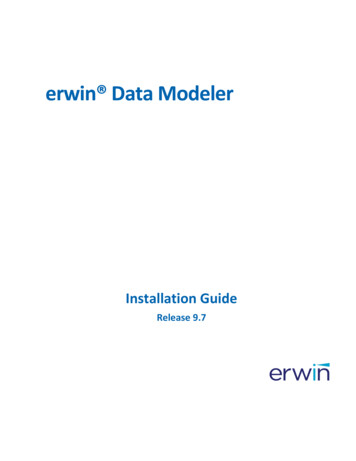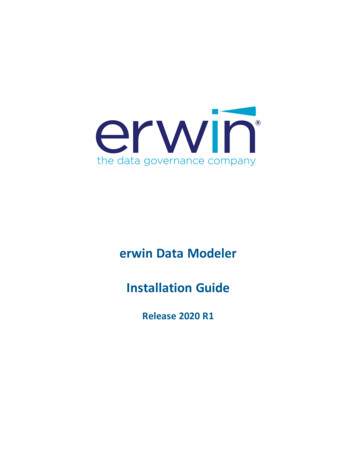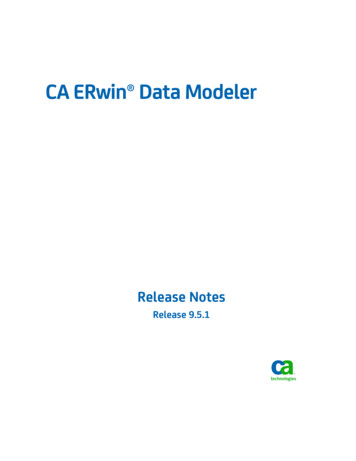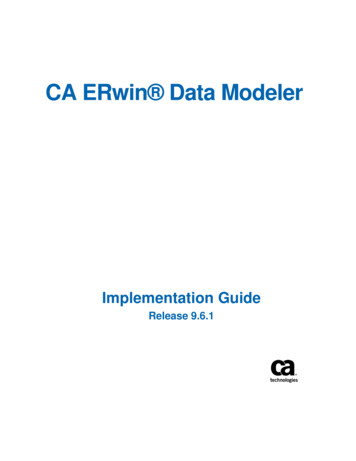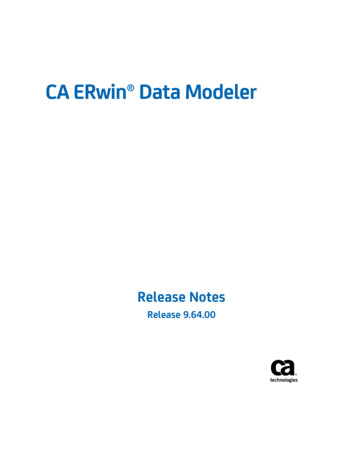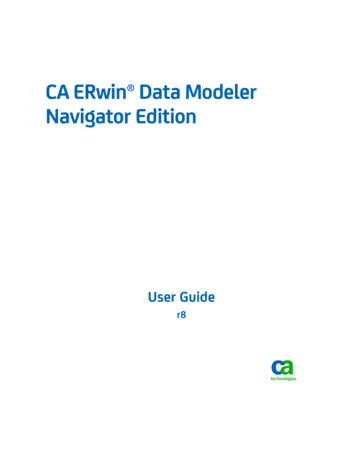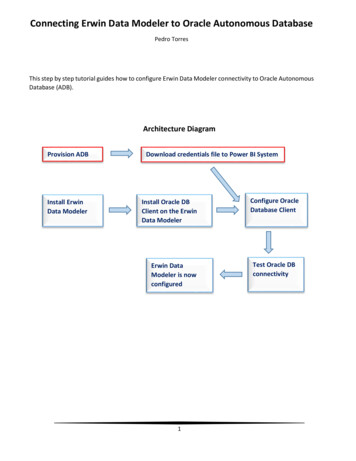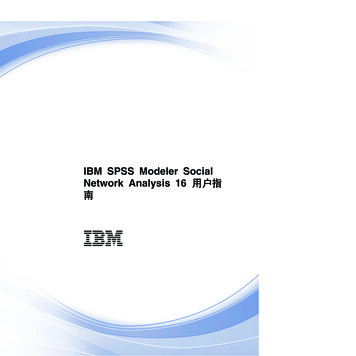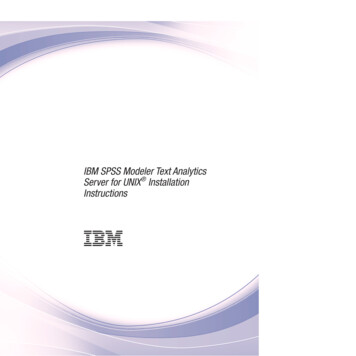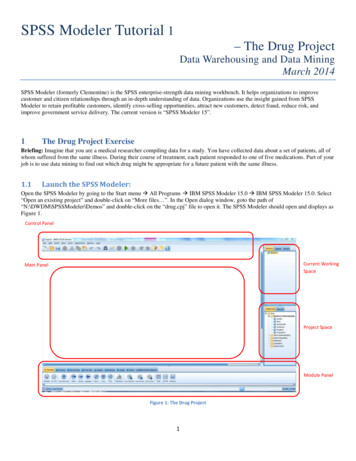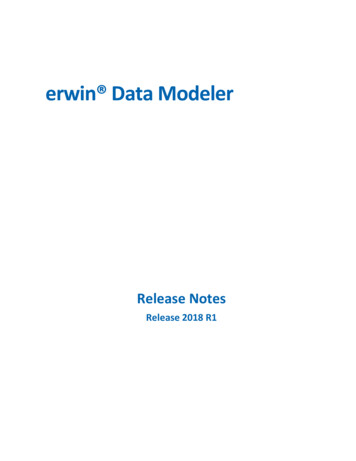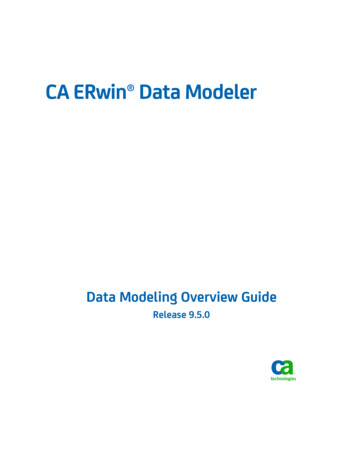
Transcription
CA ERwin Data ModelerData Modeling Overview GuideRelease 9.5.0
This Documentation, which includes embedded help systems and electronically distributed materials, (hereinafter referred toas the “Documentation”) is for your informational purposes only and is subject to change or withdrawal by CA at any time. ThisDocumentation is proprietary information of CA and may not be copied, transferred, reproduced, disclosed, modified orduplicated, in whole or in part, without the prior written consent of CA.If you are a licensed user of the software product(s) addressed in the Documentation, you may print or otherwise makeavailable a reasonable number of copies of the Documentation for internal use by you and your employees in connection withthat software, provided that all CA copyright notices and legends are affixed to each reproduced copy.The right to print or otherwise make available copies of the Documentation is limited to the period during which the applicablelicense for such software remains in full force and effect. Should the license terminate for any reason, it is your responsibility tocertify in writing to CA that all copies and partial copies of the Documentation have been returned to CA or destroyed.TO THE EXTENT PERMITTED BY APPLICABLE LAW, CA PROVIDES THIS DOCUMENTATION “AS IS” WITHOUT WARRANTY OF ANYKIND, INCLUDING WITHOUT LIMITATION, ANY IMPLIED WARRANTIES OF MERCHANTABILITY, FITNESS FOR A PARTICULARPURPOSE, OR NONINFRINGEMENT. IN NO EVENT WILL CA BE LIABLE TO YOU OR ANY THIRD PARTY FOR ANY LOSS OR DAMAGE,DIRECT OR INDIRECT, FROM THE USE OF THIS DOCUMENTATION, INCLUDING WITHOUT LIMITATION, LOST PROFITS, LOSTINVESTMENT, BUSINESS INTERRUPTION, GOODWILL, OR LOST DATA, EVEN IF CA IS EXPRESSLY ADVISED IN ADVANCE OF THEPOSSIBILITY OF SUCH LOSS OR DAMAGE.The use of any software product referenced in the Documentation is governed by the applicable license agreement and suchlicense agreement is not modified in any way by the terms of this notice.The manufacturer of this Documentation is CA.Provided with “Restricted Rights.” Use, duplication or disclosure by the United States Government is subject to the restrictionsset forth in FAR Sections 12.212, 52.227-14, and 52.227-19(c)(1) - (2) and DFARS Section 252.227-7014(b)(3), as applicable, ortheir successors.Copyright 2013 CA. All rights reserved. All trademarks, trade names, service marks, and logos referenced herein belong totheir respective companies.
CA Technologies Product ReferencesThis document references the following CA Technologies products: CA ERwin Data Modeler (CA ERwin DM)
Contact CA TechnologiesUnderstanding your SupportReview support maintenance programs and offerings.Registering for SupportAccess the CA Support online registration site to register for product support.Accessing Technical SupportFor your convenience, CA Technologies provides easy access to "One Stop" support forall editions of CA ERwin Data Modeler, and includes the following: Online and telephone contact information for technical assistance and customerservices Information about user communities and forums Product and documentation downloads CA Support policies and guidelines Other helpful resources appropriate for your productFor information about other Home Office, Small Business, and Enterprise CATechnologies products, visit http://ca.com/support.Provide FeedbackIf you have comments or questions about CA Technologies product documentation, youcan send a message to techpubs@ca.com.If you would like to provide feedback about CA Technologies product documentation,complete our short customer survey, which is also available on the CA Support website,found at http://ca.com/docs.CA ERwin Data Modeler News and EventsVisit www.erwin.com to get up-to-date news, announcements, and events. View videodemos and read up on customer success stories and articles by industry experts.
ContentsChapter 1: Introduction9Benefits of Data Modeling . 9Methods . 10Typographical Conventions . 10Chapter 2: Information Systems, Databases, and Models11Data Modeling . 11Data Modeling Sessions . 12Session Roles . 13Sample IDEF1X Modeling Methodology . 14Modeling Architecture . 15Logical Models . 16Entity Relationship Diagram . 16Key-Based Model . 16Fully-Attributed Model. 16Physical Models . 17Transformation Model . 17DBMS Model . 18Chapter 3: Logical Models19Constructing a Logical Model . 19Entity Relationship Diagram . 20Entities and Attributes Defined . 21Logical Relationships . 22Many-to-Many Relationships . 23Logical Model Design Validation . 24Data Model Example . 25Chapter 4: The Key-Based Data Model27Key Types . 28Entity and Non-Key Areas . 28Primary Key Selection. 28Alternate Key Attributes . 30Inversion Entry Attributes . 31Relationships and Foreign Key Attributes . 31Contents 5
Dependent and Independent Entities . 32Identifying Relationships . 33Nonidentifying Relationships . 34Rolenames . 35Chapter 5: Naming and Defining Entities and Attributes37Entity and Attribute Names. 37Synonyms, Homonyms, and Aliases . 38Entity Definitions . 39Descriptions . 39Definition References and Circularity . 40Business Glossary Construction . 41Attribute Definitions . 41Validation Rules . 42Rolenames . 43Definitions and Business Rules . 44Chapter 6: Relationships45Relationship Cardinality . 45Cardinality in Nonidentifying Relationships . 47Referential Integrity . 49Referential Integrity Options . 51RI, Cardinality, and Identifying Relationships. 53RI, Cardinality, and Non-Identifying Relationships. 54Additional Relationship Types . 55Many-to-Many Relationships . 55N-ary Relationships . 57Recursive Relationships . 59Subtype Relationships . 61Complete Compared to Incomplete Subtype Structures . 63Inclusive and Exclusive Relationships . 64IDEF1X and IE Subtype Notation . 65When to Create a Subtype Relationship . 66Chapter 7: Normalization Problems and Solutions67Normalization . 67Overview of the Normal Forms . 68Common Design Problems . 69Repeating Data Groups . 69Multiple Use of the Same Attribute . 716 Data Modeling Overview Guide
Multiple Occurrences of the Same Fact . 73Conflicting Facts . 74Derived Attributes . 76Missing Information . 77Unification . 79How Much Normalization Is Enough . 80Support for Normalization . 82First Normal Form Support . 82Second and Third Normal Form Support . 83Chapter 8: Physical Models85Objective . 85Support for the Roles of the Physical Model . 86Summary of Logical and Physical Model Components . 86Denormalization . 87Appendix A: Dependent Entity Types89Classification of Dependent Entities . 89Glossary91Index95Contents 7
Chapter 1: IntroductionWhile data modeling can be complex, this Overview Guide can help Data Architectsunderstand data modeling and its uses.Overall, this guide has the following purposes: Provide a basic level of understanding of the data modeling method used by CAERwin DM that is sufficient to do real database design. Introduce some of the descriptive power and richness of the IDEF1X and IEmodeling languages supported, and to provide a foundation for future learning. Provide information about the supported features of IDEF1X and IE in CA ERwinDM, and the mapping between these methods.This section contains the following topics:Benefits of Data Modeling (see page 9)Methods (see page 10)Typographical Conventions (see page 10)Benefits of Data ModelingRegardless of the DBMS you use or the types of data models you want to develop,modeling your database in CA ERwin DM has many benefits: Enables usage by database and application development staff to define systemrequirements and to communicate among themselves and with end users. Provides a clear picture of referential integrity constraints. Maintaining referentialintegrity is essential in the relational model where relationships are encodedimplicitly. Provides a logical RDBMS-independent picture of your database that automatedtools can use to generate RDBMS-specific information. This way, you can use asingle diagram to generate DB2 table schemas, and schemas for other relationalDBMSs. Lets you produce a diagram summarizing the results of your data modeling effortsand generate a database schema from that model.Chapter 1: Introduction 9
MethodsMethodsCA ERwin DM supports two methods of data modeling:IDEF1XThe United States Air Force developed the IDEF1X method. The IDEF1X method isnow used in various governmental agencies, in the aerospace and financial industry,and in a wide variety of major corporations.IE (Information Engineering)James Martin, Clive Finkelstein, and other IE authorities developed the IE method,which is widely deployed in various industries.Both methods are suited to environments where large-scale, rigorous, enterprise-widedata modeling is essential.Typographical ConventionsThe following table describes the typographical conventions used in this guide toidentify key terms:Text ItemConventionEntity NameAll uppercase, followed by the word MOVIE COPY entity"entity" in lowercaseAttribute NameAll lowercase in quotation marks"movie name"Column NameAll lowercasemovie nameTable NameAll uppercaseMOVIE COPYVerb PhraseAll lowercase in angle brackets is available for rental as 10 Data Modeling Overview GuideExample
Chapter 2: Information Systems,Databases, and ModelsThis section contains the following topics:Data Modeling (see page 11)Data Modeling Sessions (see page 12)Sample IDEF1X Modeling Methodology (see page 14)Modeling Architecture (see page 15)Logical Models (see page 16)Physical Models (see page 17)Data ModelingData modelingData modeling is the process of describing information structures and capturingbusiness rules to specify information system requirements. Data models representa balance between the specific needs of an RDBMS implementation project, and thegeneral needs of the business area that requires it.When created with the full participation of business and systems professionals, the datamodel can provide many benefits. These benefits generally fall into the following twoclasses:EffortThe staff associated with the process of creating the model.Product of the EffortThe staff primarily associated with the model.Examples of Product Benefits A data model is independent of implementation, so it does not require that theimplementation is in any particular database or programming language. A data model is an unambiguous specification of what is wanted. The model is business user-driven. The business client controls the content andstructure of the model, rather than the system developer. The emphasis is onrequirements rather than constraints or solutions. The terms used in the model are stated in the language of the business, not that ofthe system development organization. The model provides a context to focus your discussions about what is important tothe business.Chapter 2: Information Systems, Databases, and Models 11
Data Modeling SessionsExamples of Process Benefits During early project phases, model development sessions bring together individualsfrom many parts of the business. The sessions provide a structured forum wherebusiness needs and policies are discussed. Business staff typically meets others forthe first time, and meets others in different parts of the organization who areconcerned with the same needs. Sessions lead to development of a common business language with consistent andprecise definitions of terms used. Communication among participants is greatlyincreased. Early phase sessions provide a mechanism for exchanging large amounts ofinformation among business participants and transferring much businessknowledge to the system developers. Later phase sessions continue that transfer ofknowledge to the staff who will implement the solution. Session participants are better able to see how their activities fit into a largercontext. Also, parts of the project can be seen in the context of the whole. Theemphasis is on cooperation rather than separation. Over time, cooperation leads toa shift in values, and the reinforcement of a cooperative philosophy. Sessions foster consensus and build teams.Design of the data structures to support a business area is only one part of developing asystem. Function modeling, the analysis of processes (function) is equally important.Function models describe how something is done. They can be presented as hierarchicaldecomposition charts, data flow diagrams, HIPO diagrams, and so on. Developing bothyour function models and data models at the same time is important. Discussion of thefunctions that the system performs uncovers the data requirements. Discussion of thedata typically uncovers additional function requirements. Function and data are the twosides of the system development coin.Data Modeling SessionsCreating a data model involves not only model construction, but also many fact-findingsessions (meetings) to uncover the data and processes used by a business. Runninggood sessions, like running good meetings of any kind, depends on preparation andreal-time facilitation techniques. In general, include the right mix of business andtechnical experts, and facilitate the modeling sessions. Schedule modeling sessions inadvance, carefully plan to cover sets of focused material, and orchestrate it in a way toachieve the results you require.When possible, it is highly recommended that modeling of function and data be done atthe same time. Functional models tend to validate a data model and uncover new datarequirements, and helps ensure that the data model supports function requirements.12 Data Modeling Overview Guide
Data Modeling SessionsSession RolesFormal, guided sessions, with defined roles for participants and agreed upon proceduresand rules, are an absolute requirement. The following roles work well:FacilitatorA facilitator acts as the session guide and is responsible for:–Arranging the meetings and facilities–Providing follow-up documentation–Intervening during sessions, as necessary, to keep sessions on track and tocontrol the scope of the session.Data ArchitectLeads the group through the process of developing and validating the model. A dataarchitect develops the model, in real time if possible, in front of the group. The dataarchitect asks pertinent questions that bring out the important details and recordsthe resulting structure for all to see. The same individual can fill both facilitator anddata architect roles, although it can be difficult.Data AnalystActs as the scribe for the session and records the definitions of all the entities andattributes that make up the model. Using the information from the businessexperts, the data analyst can also begin to package entities and attributes intosubject areas. Subject areas are simply manageable and meaningful subsets of thecomplete data model.Subject Matter ExpertProvides the business information necessary to construct the model. You can havemore than one subject matter expert. They are business experts, not systemsexperts.ManagerParticipates in the sessions in an assigned role (such as facilitator or subject matterexpert) and keeps the process moving. The manager has the responsibility of“breaking ties” but only when necessary. The manager can be from either thesystems or business community.Chapter 2: Information Systems, Databases, and Models 13
Sample IDEF1X Modeling MethodologySample IDEF1X Modeling MethodologyCA ERwin DM was developed to support the IDEF1X and IE modeling standards. The useof various levels of models within the IDEF1X method can be helpful in developing asystem. General model levels are outlined in the IDEF1X standard. In practice, you canexpand or contract the number of levels to fit individual situations.Model levels generally span from a wide view to a narrow view, depending on projectrequirements. A wide but not too detailed view can include only the major entities thatare important to a business. A narrow view can include a level of precision required torepresent the database design in terms understandable by a particular DBMS. At thelowest level of detail, models are technology-dependent. For example, a model for anIMS database looks different from a model for a DB2 database. At higher levels, modelsare technology independent and can represent information that is not stored in anyautomated system.The modeling levels presented are suited to a top-down system development lifecycleapproach, where successive levels of detail are created during each project phase.The highest level models come in two forms:Entity Relationship Diagram (ERD)Identifies major business entities and their relationships.Key-Based (KB)Sets the scope of the business information requirement (all entities are included)and begins to expose the detail.The lower-level models also come in two forms:Fully-Attributed (FA)Represents a third normal form model that contains all of the detail for a particularimplementation effort.Transformation Model (TM)Represents a transformation of the relational model into a structure, which isappropriate to the DBMS chosen for implementation. The TM, in most cases, is nolonger in third normal form. The structures are optimized based on the capabilitiesof the DBMS, the data volumes, and the expected access patterns and rates againstthe data. In a way, a TM is a picture of the eventual physical database design.DBMS ModelThe database design is contained in the DBMS Model for the system. The DBMSModel can be a project level model or an area level model for the entire integratedsystem.14 Data Modeling Overview Guide
Modeling ArchitectureModeling ArchitectureFive modeling levels are presented in the following illustration. Notice that the DBMSmodel can be at either an Area Level scope, or a Project Level scope. It is not uncommonto have single ERD and KB models for a business, and multiple DBMS models. You canhave one DBMS model for each implementation environment, and another set withinthat environment for projects that do not share databases. In an ideal situation, there isa set of Area Level scope DBMS models. One Area Level scope DBMS model for eachenvironment, with complete data sharing across all projects in that environment.The models fall into two categories: Logical PhysicalChapter 2: Information Systems, Databases, and Models 15
Logical ModelsLogical ModelsThere are three levels of logical models that are used to capture business informationrequirements: Entity Relationship diagram Key-Based model Fully-Attributed modelThe Entity Relationship diagram and the Key-Based models are also known as area datamodels. They often cover a wide business area that is larger than the business choosesto address with a single automation project. In contrast, the Fully-Attributed model is aproject data model. Typically it describes a portion of an overall data structure intendedfor support by a single automation effort.Entity Relationship DiagramThe Entity Relationship diagram (ERD) is a high-level data model that shows the majorentities and relationships, which support a wide business area. An ERD is primarily apresentation or discussion model.The ERD objective is to provide a view of business information requirements to satisfythe need for broad planning for development of its information system. These modelsare not detailed (only major entities are included), and not much detail, if any, onattributes. Many-to-many (nonspecific) relationships are allowed, and keys are generallynot included.Key-Based ModelA key-based (KB) model describes the major data structures, which support a widebusiness area. All entities and primary keys are included with sample attributes.The objective of the KB model is to provide a broad business view of data structures andkeys required to support the area. A KB model provides a context where detailedimplementation level models can be constructed. The model covers the same scope asthe Area ERD, but exposes more of the detail.Fully-Attributed ModelA full
CA ERwin Data Modeler News and Events Visit www.erwin.com to get up-to-date news, announcements, and events. View video demos and read up on customer success stories and articles by industry experts. Contents 5 Contents Chapter 1: Introduction 9
